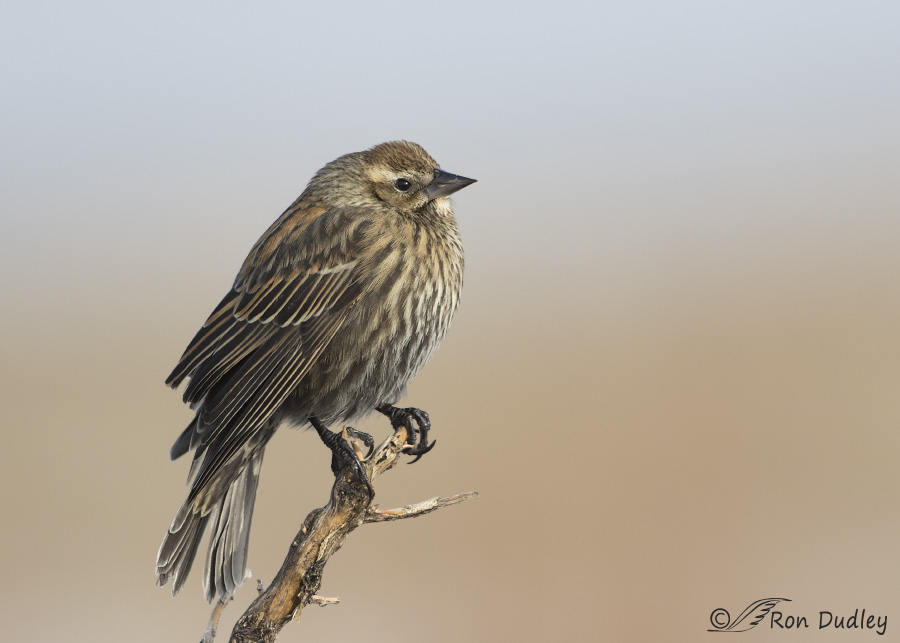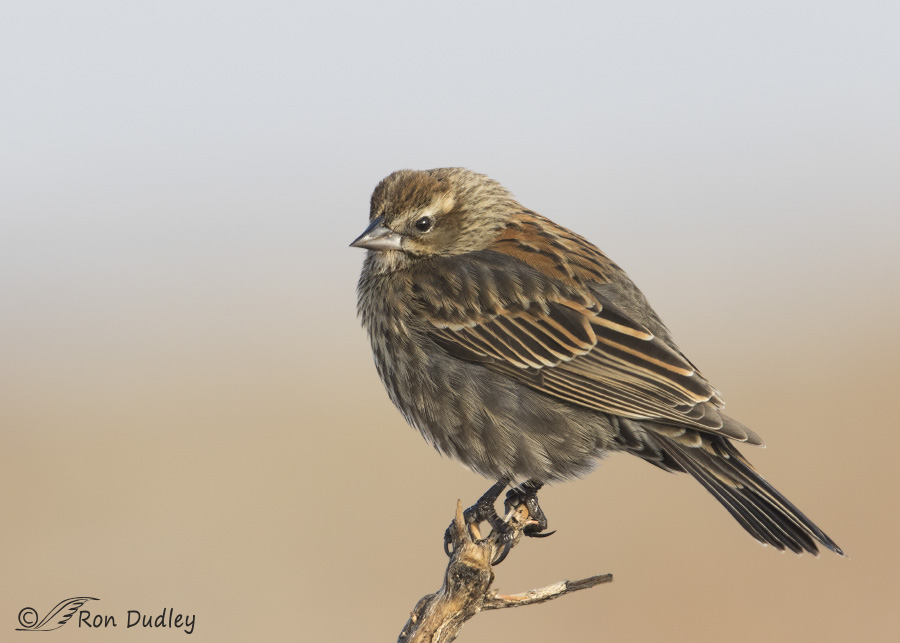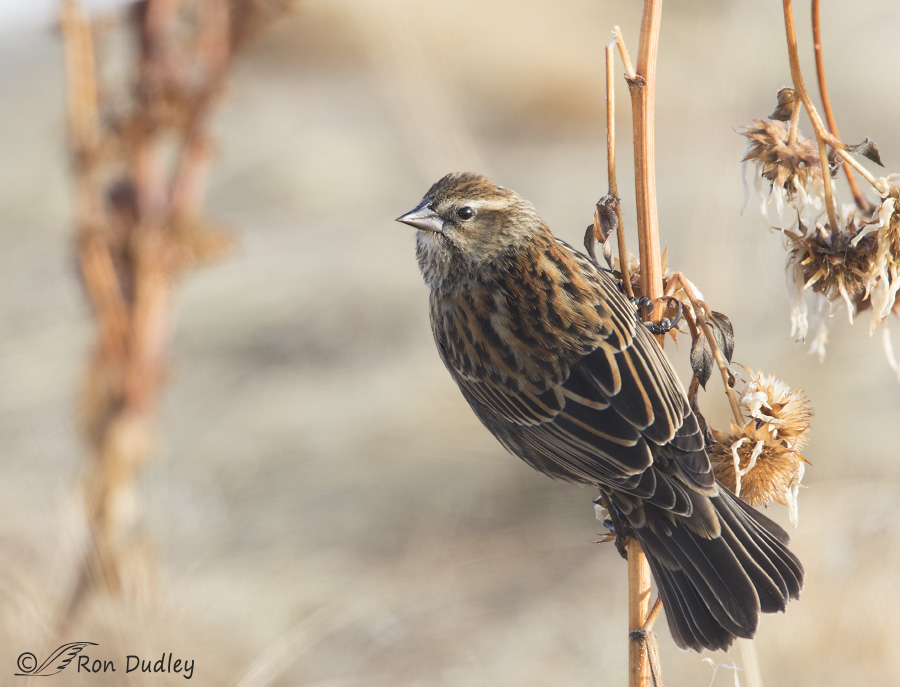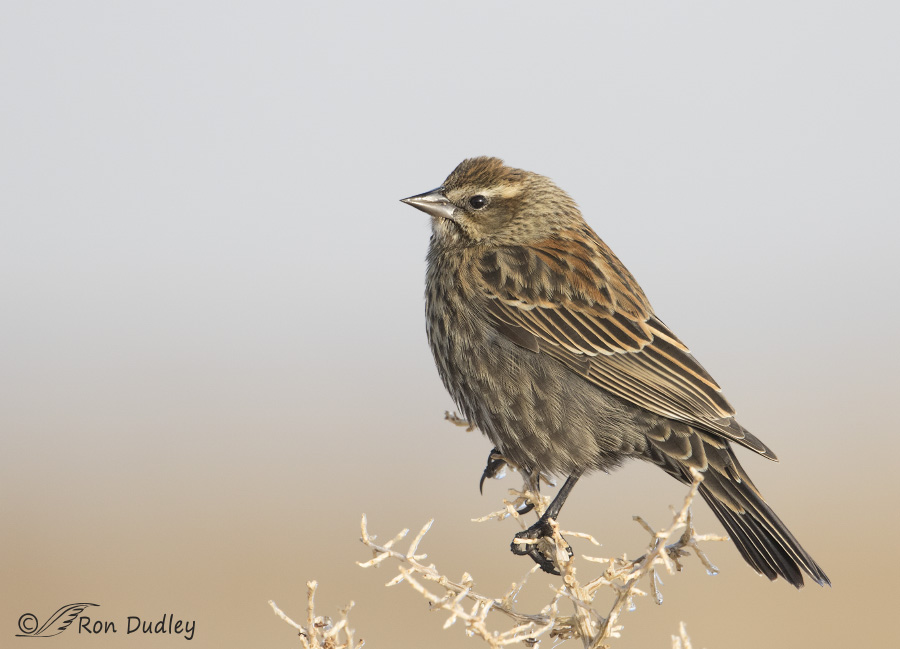I sometimes have to remind myself not to ignore the common species.
It’s not that I really ignore them because given a good opportunity I’ll photograph almost anything with feathers (heck, I even photographed a Starling yesterday) but I catch myself not trying as hard with common birds and even with females and that’s a mistake. They’re all potentially interesting subjects, no matter the species and no matter the sex.

1/1600, f/6.3, ISO 800, Canon 7D Mark II, Canon EF 500mm f/4L IS II USM + 1.4 tc, not baited, set up or called in
I found this cooperative female Red-winged Blackbird four days ago at the White Rock Bay Campground on Antelope Island. It was a cold and cloudy morning but we had a fortuitous “sucker hole” in the clouds for about 20 minutes and when the warming light appeared she alternated between basking in the sun on some elevated perches and foraging on the ground. Here she’s warming up a little on a dead greasewood branch.
Apparently she didn’t think she was showing me her best side because…

1/1000, f/8, ISO 800, Canon 7D Mark II, Canon EF 500mm f/4L IS II USM + 1.4 tc, not baited, set up or called in
she turned on her perch and presented the other.

1/500, f/8, ISO 800, Canon 7D Mark II, Canon EF 500mm f/4L IS II USM + 1.4 tc, not baited, set up or called in
Then she flew down to the ground to forage a bit but soon she jumped up a few inches and landed on this dead sunflower stem for about three seconds before hopping down to look for more seeds.

1/2000, f/6.3, ISO 800, Canon 7D Mark II, Canon EF 500mm f/4L IS II USM + 1.4 tc, not baited, set up or called in
Then she landed on one last nearby perch to warm up a little before she flew off with several companions.
It’s been said that the Red-winged Blackbird is perhaps the most abundant and most commonly studied bird of North America so my choice of this bird as an example of a common species is a good one. Maybe one day I’ll even train my lens on a House Sparrow.
Nah…
Ron


Outstanding series Ron!
Charlotte
What a lovely series Ron. And don’t apologize for sharing the more every day birds. They bring a special beauty and I, for one, bristle at the term “common.” It carries a lot of unnecessary baggage with it that should never be applied to birds or critters of any sort. Mariah, female redtail hawk, told me that more appropriate words to describe them are “plentiful” or “abundant.” Just sayin’!
I see these birds all the time in Georgia!
By the way, your blog is great!
Beautiful.
Thank you, Sharon.
I can’t wait to see the return of these little ladies in their striped jump suits because they represent one of the first solid signs of Spring. They arrive in big flocks of mixed blackbirds( starlings, grackles and redwings). This is a wonderful series, the detail is so sharp, the fluffed up poses so cute,the composition so spot on. It demonstrates so clearly that, in the females especially, it’s so often the patterns and subtlety of coloration rather than just the colors that make them beautiful….I hope you will take more pictures of the less showy, more “common” birds….and, I hope they will continue to be “common” for a long, long time…..
Check with Mia the Incredible Plant Person about plant in second frame…looks like Monarda or Cleome to me, rather than a Sunflower. If anyone would know, she would…..
“I hope they will continue to be “common” for a long, long time…..”
That’s for darned sure, Patty. These days you never know.
I’m sticking with sunflowers…
Be that way….:-)
I love your series on this beautiful little bird, Ron. We are starting to see the Red Wing Black birds at Green Cay and they are very friendly, which is partly why I like them so much. What I’ve learned from your blog today is that I’ve never seen the female !! Will start watching for her since I’m off to Green Cay today!!
I hope you see some of the females today, Jo Ann. Thanks.
Hi Ron,
Must be that time of year. I was helping with Project Feeder Watch at our local city park yesterday and was asked to ID a bird for someone. The bird? A female Red-winged Blackbird. I don’t know the species’ molt sequence, but several of the feeder birds appeared to be in “fresh” plumage. Very nice! Thanks, as always, for the great images.
Cheers,
Dick
Thank you, Dick. BTW, I’m jealous of the image of a Ferruginous Hawk you posted on FB this morning. They’re really scarce around here this winter, at least for me.
Thanks, Ron. Truth in lending, and a lesson learned re Facebook – I originally posted two images and stated they were taken by my very good friend, Frank Lospalluto, who had given me permission to post. Someone commented on an individual image, which resulted in Facebook separating it into a separate post sans my text. Apparently that is what FB automatically does. In any event, I see and bird with Frank regularly, and I’ll tell him you liked the shot. He is aware of your work, so I’m sure it will bring a smile to his face.
BTW, there are a lot of Ferruginous Hawks in Butte Valley, CA, so far this season. I believe Belding’s Ground Squirrels being out and about have something to do with it. Here’s hoping there are enough squirrels to last until the Winter Wings Festival in mid-February….
Here’s hoping there are enough squirrels to last until the Winter Wings Festival in mid-February….
Cheers,
Dick
Well, he did a nice job with it. And thanks (not) for keeping all the Ferrugs and not letting them come my way!
I’m getting the impression that there’s a lot of them wintering in northern Montana – the Richardson’s Grounds squirrels may have something to do with that.
Thank you for the beautiful photos. She’s a lovely little bird in her own right. That pointy, chiseled beak sure looks like a formidable weapon if need be! I probably see these birds everyday and without the colorful males present, still wouldn’t have known what it was without you telling us. I really like the photo of her on the sunflower where she appears to be hanging there posing and looking back at you as if to say “How about this shot?”
Thanks, Mark. I was lucky to get that shot because she was only there for a couple of seconds and she only turned to look back at me for an instant.
BRRR! Nice photo’s of the female – they do tend to be less noticeable – so much so that for a long time I didn’t know what they were.:) We get MANY males at the feeders in the spring that become a nuisance preventing other birds from feeding.
Judy, lots of folks don’t recognize the females so don’t feel like the Lone Ranger. Throw in juveniles and it can become even more confusing.
Very nice shots of a female in various poses. You can feel the cold just by looking at her perched and scrunched up.
I have always liked the shades of brown and tan and how they are distributed over her plumage. The black centers to the primaries and secondaries edged with dark tan all a perfect camouflage for a ground nesting bird.
Thanks for sharing!
I feel like you do about plumages like this, Dick. Another somewhat similar one is the dorsal side of both meadowlark species. I’ve always enjoyed the patterns and colors back there. Thank you.